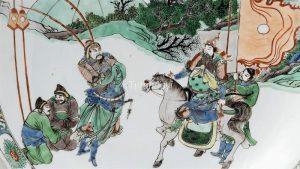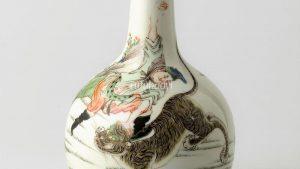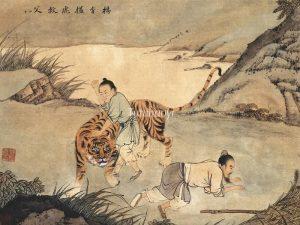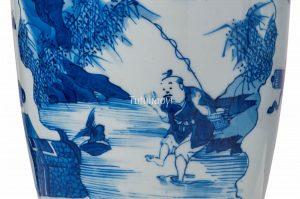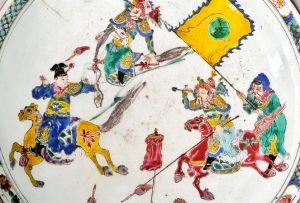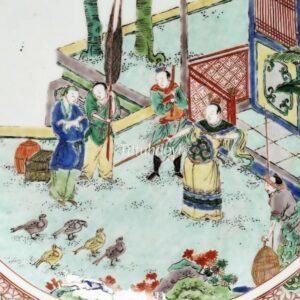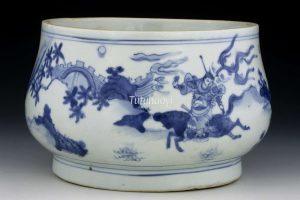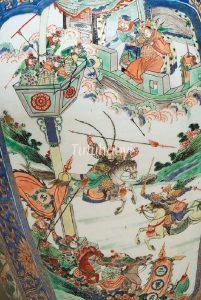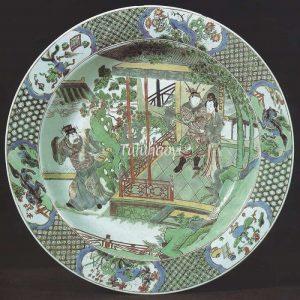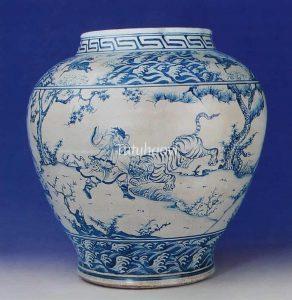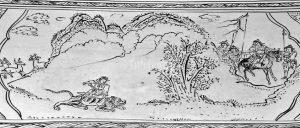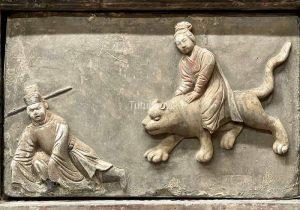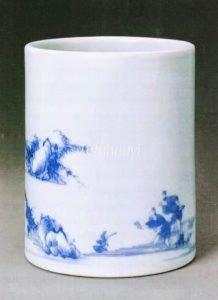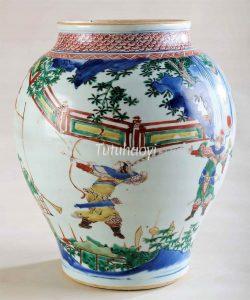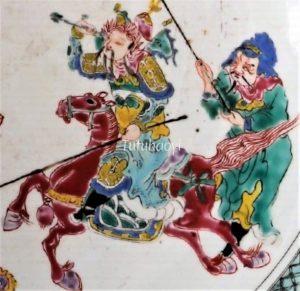Showing Results Containing
General Guo Ziyi deterring the mighty enemy has been a famous event in ancient China around mid-8th century. Deciphering this story scene on Chinese porcelain plates and tiles, however, has not been straightforward and has taken iconography specia...
‘Wu Song slaying the tiger’ is a popular fictional story among Chinese people. But it’s hardly noticed that this story scene has been chosen in Chinoiserie decorative art in Europe. Here is Dr Yibin Ni’s interesting research and his unique insight...
‘Yang Xiang trying to throttle the tiger to rescue her father’ is a well-known story passed down from generation to generation in ancient China. However, Yang Xiang has sometimes been portrayed as a male figure on traditional Chinese artworks. Let...
People who are not familiar with Chinese history and parables may have the impression that the above image is a genre painting of fisherman’s daily life. But in fact, there is more meaning to it. Dr Yibin Ni will explain the story in detail and ho...
Xiahou Dun, a heroic soldier in ancient China, was famous for his one-eyed appearance. Let’s appreciate how Dr Yibin Ni analyses the artistic presentation of this character on Chinese antique porcelain, woodblock print and other art forms, in asso...
Jia Chang (贾昌 712–810) from the Tang Dynasty was renowned for his exceptional skills in training roosters for cockfighting. His legendary story is recorded in the Extensive Records of the Ta...
According to the ‘Account of Zhao Yun’ (赵云传) in ‘The Records of the Three Kingdoms’ (三国志), Zhao Yun (styled Zilong, 子龙) was a distinguished general serving under his warlord, Liu Bei 刘备. It is said that Zhao was not only handsome and sturdy-built, but also brave and skilled in battle. In Chapters 41 to 42 of ‘Romance of ...
Qin Shubao (秦叔宝, or Qin Qiong 秦琼, ?–638,) and Luo Cheng 罗成 were cousins, and they were characters in the Qing Dynasty novel Complete Biography of Explaining the Tang Dynasty 《说唐演义全传》 (Shuo Tang Yanyi Quan Zhuan, author unknown).
Luo Cheng was invited by General Yang Yichen 杨义臣 to guard an extremely diffic...
Guo Ziyi (郭子仪 697–781), posthumously bestowed the title Prince Zhongwu of Fenyang (汾阳忠武王) because of his birth place and his contribution to the court, was the greatest Tang-dynasty general. He played the key role in military campaigns against the Uyghur Khaganate and Tibetan Empire, enemies constantly threatening China ...
Dong Zhuo (董卓 d. 192), a tyrannic warlord rising to power at the end of the Han dynasty, caused great concern among courtiers and officials. Wang Yun (王允), the Minister Over the Masses (司徒 Situ), was entrusted to figure out a plan to bring him down. Dong Zhuo was particularly powerful because he managed to ally ...
Nicknamed xingzhe (行者), ‘Pilgrim’ or ‘Traveller’, Wu Song (武松) is a popular fictional figure well-known for his slaying a tiger single-handedly after he was into...
One day during the Tang dynasty (618-907), Li Keyong (李克用, 856-908), the Prince of Jin (晋王), went out hunting with an entourage of dozens of soldiers, when he encountered a woodcutter in a quiet valley. The woodcutter told Li that The Flying Tiger Hill nearby was an ideal hunting ground. The prince told him that he had d...
Early in Jin dynasty (晋 265–420), Yang Feng 杨丰 and his teenage daughter, Yang Xiang 杨香, were harvesting the millet crops in the fields when he was attacked by a tiger. Th...
The story scene refers to an old Chinese saying: in the fight between the sandpiper and the clam, the fisherman has the best of it. This parable came from an ancient Chinese text entitled ‘Strategies of the Warring States (战国策 Zhanguo Ce)’. The book contains anecdotes of diplomacy and warfare during the Warring ...
Lv Bu (吕布 Lü Bu, died 199 CE) is known as an almost unchallenged fighter in the period of the Three Kingdoms (三国, 220-280 CE) in Chinese history. The scene on the vase depicts a crucial moment when Lv Bu’s exceptional archery stunt astounded all the generals and soldiers present and then successfully quelled an ...
Xiahou Dun (夏侯惇, died 13 June 220) was one of Cao Cao’s (曹操, 155-220) most valued generals in the late Eastern Han dynasty (东汉, 25-220) of China. Xiahou showed his strong temperament even when he was in his early teens. Once his mentor was insulted, and he went straight to the insulter and killed him. During the 190s in ...
